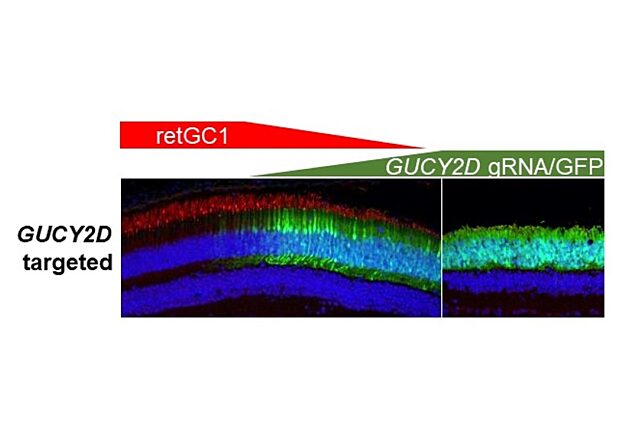UF Health researchers’ gene editing approach for eye disorder shows promise in preclinical model

An adeno-associated virus vector (seen here in green) acts like a pair of “genetic scissors,” eliminating a key protein and knocking out the GUCY2D gene (shown in red).
GAINESVILLE, Fla. — Using a type of “genetic scissors,” University of Florida Health researchers have successfully removed and replaced a malfunctioning gene that gradually damages photoreceptors in the eye. Working in mouse models, the researchers say the findings are a crucial step in developing a treatment for the disorder known as cone-rod dystrophy 6.
For patients with the condition, also called CORD6, the stakes are high: Light-sensing cone cells in the retina at the back of the eye are damaged by a genetic mutation, leading to loss of central vision and color vision as well as excessive light sensitivity. By about age 30, most patients have lost sharp, clear vision.
To counter that, researcher Shannon E. Boye, Ph.D., and her collaborators put their genetic scissors to work on CORD6, cutting out the mutant gene (GUCY2D) that produces a toxic function in the retina and replacing it with a healthy copy.
“We go in and cut the early coding sequence of the gene to get rid of it. Simultaneously, we deliver a hardened, healthy version of that same gene that can’t be cut by the scissors,” said Boye, a professor and the associate division chief for cellular and molecular therapy in the College of Medicine’s department of pediatrics.
The results in mice are proof of principle that the technique — known as “ablate and replace” —works and has the potential to become a therapy for humans, Boye said. The findings were published recently in the journal Molecular Therapy: Methods & Clinical Development.
To establish their findings, the researchers treated one eye in the mice with a treatment known as AAV-CRISPR-Cas9 to disrupt both the malfunctioning and normal, non-mutated versions of GUCY2D. To the same eye, they delivered a healthy copy of GUCY2D that was designed to have resistance to the CRISPR-Cas9 reagents. Overall, the treatment resulted in “significant preservation” of photoreceptors and improvements in retinal function. They found the treatment to be durable, protecting the eye’s rod and cone cells for at least 20 weeks — an age equivalent to about 30 years in humans.
As a dominant genetic mutation in which one copy of a mutated gene is enough to cause a disorder, CORD6 posed a more significant scientific challenge to Boye and her collaborators. Unlike a simpler form of gene therapy that simply replaces a mutated gene with a properly functioning copy, the researchers first had to eliminate the rogue gene before replacing it, Boye said.
The study results show that the “ablate and replace” treatment provides crucial early support for development of a CORD6 treatment that could be tested in humans, the researchers concluded. The findings also have implications beyond CORD6: The same gene editing technique may also be applicable to treating a broader range of inherited retinal diseases, Boye said.
“I’m extremely proud of the hard work that both Russell Mellen, Ph.D., and K. Tyler McCullough, Ph.D., both put in to this project, as it was really the first time the lab has tackled a dominant retinal disease,” Boye said of her two former graduate students.
Next, the researchers plan to test the technique in a different type of genetically modified mouse that more closely replicates CORD6 in humans. The technique is also poised for a future research partnership with private industry.
“We have the tools and the results in hand. We’re ready to go. We just need the funding to make it happen,” Boye said.
The research was funded by a National Institutes of Health grant.
About the author
